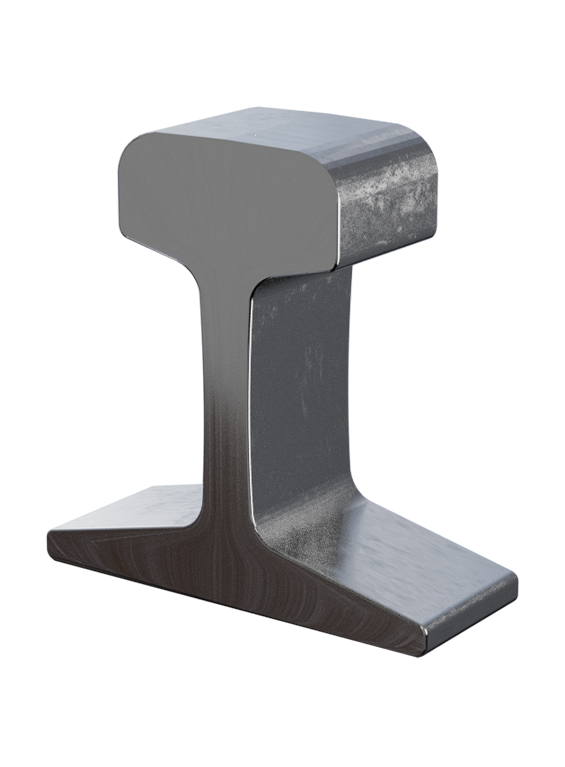
Light Rails
In the early days of railroading, rolling stock and the loads they carried were much lighter than they were to become. One of the first rails with the familiar “I” shape originated in the UK in 1829. Coincidentally, Stephenson’s Rocket locomotive was created in the same year. These rails weigh just 36 lbs/yard (17.9 kg/m) whereas a modern Transport rail might be 136 lbs/yard (67.4 kg/m).
Over time, lightweight rails have been superseded by larger & heavier rails for transportation purposes. Mining was an early adopter, and lightweight rails found other uses: light crane systems, assembly lines, automated warehouse retrieval systems, hanger doors, amusement parks and even car washes, to name only a few. As this shift took place, Light Rail formed a class distinct from Transportation Rail. Different countries have developed their own standards and the rails themselves evolved with different shapes, sizes and specifications. European and American standards dominate the Light Rail market.
Basic Dimensions
| Profiles | Weight | Head width | Height | Base width | Web | ||||||||||
|---|---|---|---|---|---|---|---|---|---|---|---|---|---|---|---|
| kg/m | lb/yd | mm | in | mm | in | mm | in | mm | in | ||||||
| ASCE20 | 9.92 | 20.00 | 34.13 | 1 11/32 | 66.67 | 2 5/8 | 66.67 | 2 5/8 | 6.35 | 1/4 | |||||
| ASCE25 | 12.40 | 25.00 | 38.10 | 1 1/2 | 69.85 | 2 3/4 | 69.85 | 2 3/4 | 7.54 | 19/64 | |||||
| ASCE30 | 14.88 | 30.00 | 42.86 | 1 11/16 | 79.38 | 3 1/8 | 79.38 | 3 1/8 | 8.33 | 21/64 | |||||
| ASCE40 | 19.84 | 40.00 | 47.62 | 1 7/8 | 88.90 | 3 1/2 | 88.90 | 3 1/2 | 9.92 | 25/64 | |||||
| ASCE45 (JIS22) | 22.32 | 45.00 | 50.80 | 2 | 93.66 | 3 11/16 | 93.66 | 3 11/16 | 10.72 | 27/64 | |||||
| ASCE50 (TR25) | 24.80 | 50.00 | 53.98 | 2 1/8 | 98.43 | 3 7/8 | 98.43 | 3 7/8 | 11.11 | 7/16 | |||||
| ASCE60 | 29.76 | 60.00 | 60.33 | 2 3/8 | 107.95 | 4 1/4 | 107.95 | 4 1/4 | 12.30 | 31/64 | |||||
| ASCE75 (JIS37, TR37) | 37.20 | 75.00 | 62.71 | 2 15/32 | 122.24 | 4 13/16 | 122.24 | 4 13/16 | 13.50 | 17/32 | |||||
| ASCE80 | 39.68 | 80.00 | 63.50 | 2 1/2 | 127.00 | 5 | 127.00 | 5 | 13.89 | 35/64 | |||||
| ASCE85 | 42.30 | 85.27 | 65.09 | 2 9/16 | 131.76 | 5 3/16 | 131.76 | 5 3/16 | 14.29 | 9/16 | |||||
Mechanical properties
| Profiles - Grades available | ≥ 155 HB | ≥ 201 HB | ≥ 260 HB | ≥ 285 HB | ≥ 321 HB |
|---|---|---|---|---|---|
| ASCE20 | √ | ||||
| ASCE25, ASCE30, ASCE40, ASCE45, ASCE50 | √ | ||||
| ASCE60, ASCE75 | √ | √ | √ | ||
| ASCE80 | √ | √ | √ | √ | |
| ASCE85 | √ | √ |
Drilling
| Rail profile | Spacing | Hole diameter | Elevation | ||||||||||
|---|---|---|---|---|---|---|---|---|---|---|---|---|---|
| A | B | D | E | ||||||||||
| mm | in | mm | in | mm | in | mm | in | ||||||
| ASCE20 | 50.80 | 2 | 101.60 | 4 | 15.88 | 5/8 | 29.80 | 1 11/64 | |||||
| ASCE25 | 50.80 | 2 | 101.60 | 4 | 15.88 | 5/8 | 31.35 | 1 15/64 | |||||
| ASCE30 | 50.80 | 2 | 101.60 | 4 | 19.05 | 3/4 | 35.32 | 1 25/64 | |||||
| ASCE40 | 63.50 | 2 1/2 | 127.00 | 5 | 22.23 | 7/8 | 39.69 | 1 9/16 | |||||
| ASCE45 (JIS22) | 63.50 | 2 1/2 | 127.00 | 5 | 22.23 | 7/8 | 41.67 | 1 41/64 | |||||
| ASCE50 (TR25) | 63.50 | 2 1/2 | 127.00 | 5 | 22.23 | 7/8 | 43.66 | 1 23/32 | |||||
| ASCE60 | 63.50 | 2 1/2 | 127.00 | 5 | 23.81 | 15/16 | 48.42 | 1 29/32 | |||||
| ASCE75 (JIS37,TR37) | 66.68 | 2 5/8 | 139.70 | 5 1/2 | 25.40 | 1 | 53.78 | 2 15/128 | |||||
| ASCE80 | 63.50 | 2 1/2 | 127.00 | 5 | 25.40 | 1 | 55.56 | 2 3/16 | |||||
| ASCE85 | 63.50 | 2 1/2 | 127.00 | 5 | 28.58 | 1 1/8 | 57.55 | 2 17/64 | |||||
Description
In the interest of standardization, the American Society of Civil Engineers (or ASCE) developed a set of rail profiles in 1893. These rails all have a height equal to the width of their bases, and share the same proportions of steel weight in the head, web & foot.
The ASCE rails quickly spread all over the world with production taking place in mills far from the USA. With many producers of the same products, it was not uncommon for each Mill to follow its own standards and naming conventions. For example, ASCE45 is known as JIS22 under the Japanese Industrial Standards. Similarly, the Brazilian TR25 is the same as the ASCE50 rail. The TR is from the Portuguese ‘trilho’ or rail.
American Light Rails are produced under the dimensional tolerances and mechanical properties defined in the ASTM A1/00 technical specification.
American Light Rails are produced in standard lengths of 20, 30, 33, 39, 40, 60, 78 and 80 feet (≈ 6, 9, 10, 12, 18 and 24 meters). Other lengths are also available upon special request. The ends can be finished as needed, either non-drilled (blank) for welding or drilled with 2 holes for joint bars.
